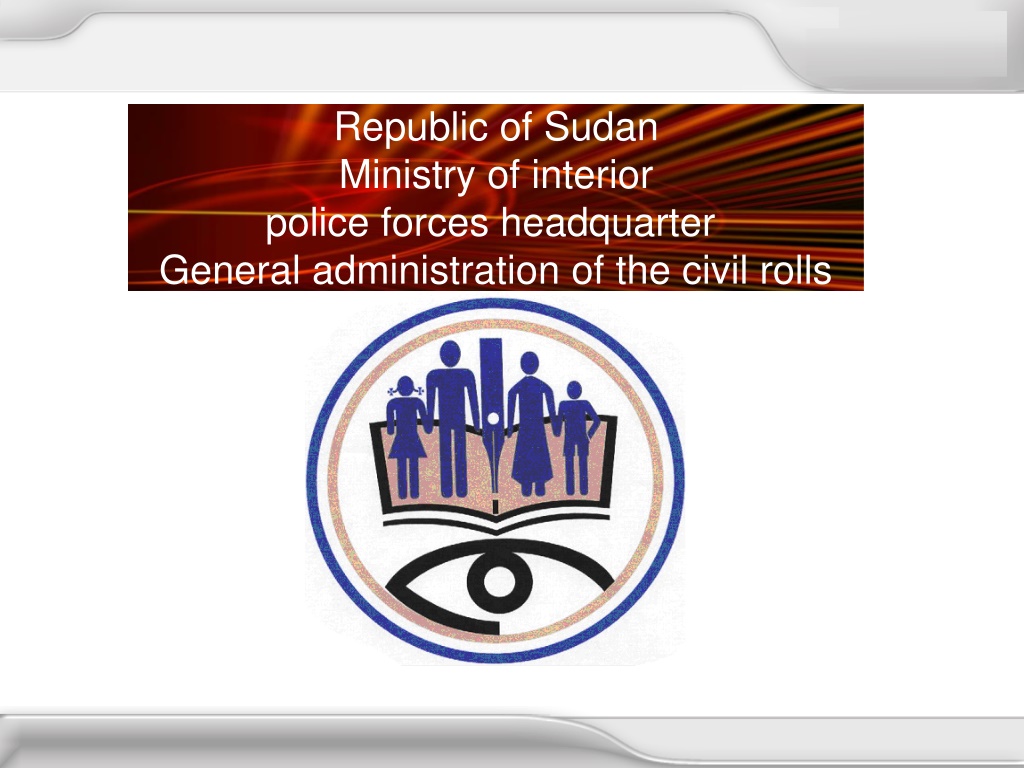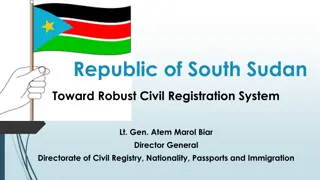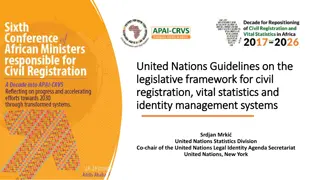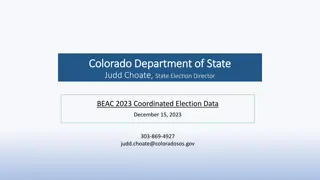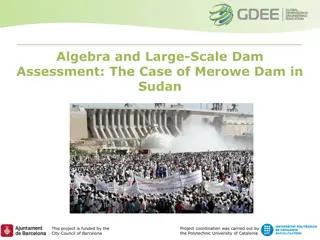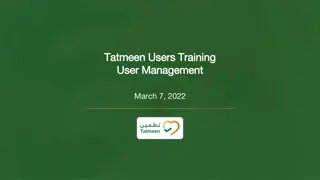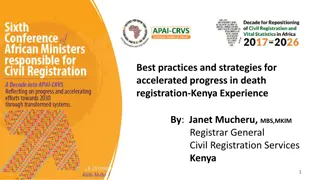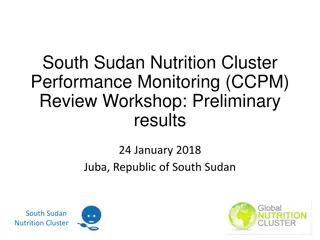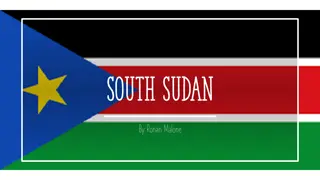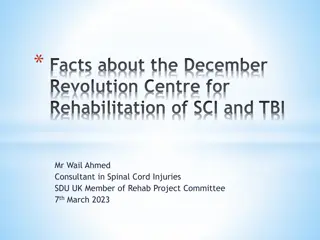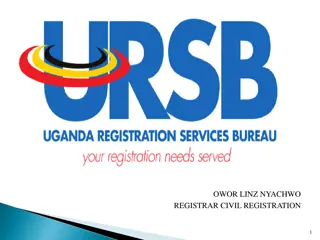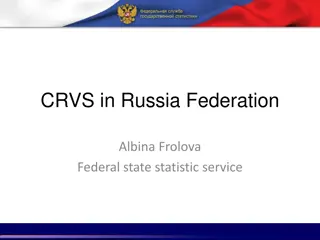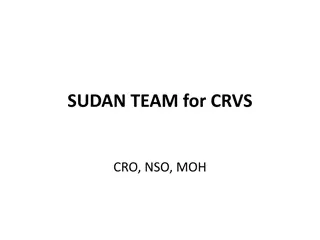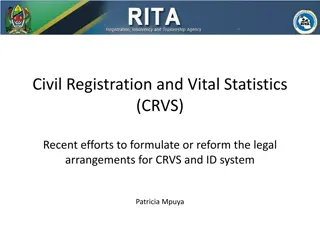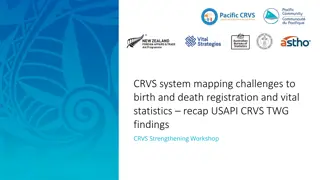Enhancing National Security: Sudan's Civil Registration Strategy
Sudan has implemented a strategic plan since 1998 to strengthen national security through a comprehensive civil registration system. This system includes the issuance of national identity cards and vital event certificates, with a focus on compliance with international standards and regulations, environmental considerations, security issues, and modernization of citizen services. The Ministry of Interior in Sudan is committed to improving governance services and ensuring a secure national identification process.
Uploaded on Oct 09, 2024 | 0 Views
Download Presentation

Please find below an Image/Link to download the presentation.
The content on the website is provided AS IS for your information and personal use only. It may not be sold, licensed, or shared on other websites without obtaining consent from the author. Download presentation by click this link. If you encounter any issues during the download, it is possible that the publisher has removed the file from their server.
E N D
Presentation Transcript
Republic of Sudan Ministry of interior police forces headquarter General administration of the civil rolls
Sudan Overview 30 Million Population (More than 60% of the Population is under 24 Years of age) (35%) Urban Population A Federal System with (18) States. A gate way between North, East and Central Africa. NORTHERN ESTATE RED SEA NORTHERN DARFUR NAHR ELNIL STATE KASSALA KHARTOUM NORTH KORDOFAN WEST DARFUR WEST KORDOFAN SOUTH DARFUR SOUTH KORDOFAN 2
Sudan Overview Sudan is a vast country, it is the third largest country in Africa, after Algeria and DR Congo, The length of Sudan's borders is 6,751 kilometers. surrounded by 7 different countries. Border countries are: Central African Republic (175 km),Chad (1,360 km), Egypt (1,275 km),Eritrea (605 km),Ethiopia (769 km), Libya (383 km) South Sudan (2,184 km). It is definitely a very unique situation, with this: Almost all the inhabitances near the stretching borders are nomadic tribes, who truly have no motivations towards the politically drawn borders Also we find a lot of Refugees and asylum seekers originate from the neighboring countries, due many different reasons 3
The Strategy With all above in mind, the Sudan since 1998 planned a very strict strategy to insure the Sudanese Nationality, and to highly secure the National Identification methods of the citizens and inhabitants. The Vision was to adopt the latest IT technologies available to fulfill and produce the most modern Citizen Identification documents, by: Registration of citizens and theirs vital events. Registration of foreigners and Refugees (with vital events). Granting a Unique National Id Number . Hence : 4
The Strategy Build of the required infrastructure Issuance of the National Identity Cards Issuance of vital events certificates The most important aspects of the message of the strategy were, compliance with the latest International standards and regulations, putting in mind the impact on: Environmental constrains Security issues Social, Economical and Political prevailing situations Modernization of the services offered to our citizens Improvement of life style and standards 5
The Strategy The Ministry of Interior of the Republic of the Sudan confronted these difficult aspects, in order to pave the paths towards stricter national security and a better e- governance services. 6
The Civil Registration System The Civil Registration System
CRS is the Heart of the e-Government Systems Other Applications and Systems Automated Border Control System (ABCS) National Identity Card System (NIDS) Outside world Web based E-Government Automated Fingerprint Identification System (AFIS) CRS E-Passport System Other MoI Applications and Services Data Backup, Warehousing & DRC Solutions 8
Civil rolls project the Civil Registry Department is to register all individuals present on the territory of Sudan in a central national database. The Civil Registry also intends to keep the central database updated with four events: births, deaths, marriages and divorces. The events will be registration which will take place at government institutions dealing with the particular events as well as Civil Registry offices across the country. The aim of recorded through continuous 15
Civil rolls project The registration of Sudanese nationals and the issuance of the national number were commenced in Khartoum in May 2011. The procedure has since rolled out to most of the states in Sudan through the establishment of permanent Civil Registration Centres in each state capital. Teams using mobile registration units have been deployed outside the state capitals to reach populations in remote areas. 16
The objectives Protecting and adjusting the Sudanese identity. Establishing central database for the population. To proof the familial origins, families connections and setting the inheritance. To continuously register, update and analyze the information. Issuing the identification documents and protecting them against counterfeiting and forgery. Coordinating with the other relevant bodies. The civil rolls is considered as a referential record that helps in preparing the lists for the political participations and in the other citizens rights that need it. 17
The social importance of the civil rolls project Realizing continuously. Developing the services and providing it through advanced means to save the citizen time and efforts. Organizing the familial and social relationships. To be able to determine the genealogy and the familial origins. To be able to determine the inheritance s relationships. The advanced social planning for social development purposes. Better educational and health planning as the civil rolls provides statistical indicators of the population with high potentials that help in combating the negative phenomena as fast as possible. Enable the state to develop the luxurious expenditure and provide services and aids to the different sectors of the population. the social justice by providing the basic services 18
A communication network has been built to meet the requirements of the working operating system. The most important features of the network: - to cover the whole Khartoum state via wireless communication network with high and advanced technical standards transmission capacity and a good insurance means. It also provides a backup network that uses SHEDSL techniques presented by the Sudanese telecom. - to complete connecting the civil rolls offices in the northern states via wired network using the frame relay or SHDSL techniques as available. - using the fiber optics to connect all the civil rolls links together with the center. Networks and communications with a large 20
Data center The data center has been well prepared with standards corresponding with the real needs of the civil rolls project particularly in the following: - the large total storage capacity of the data center. - the huge rapidity of data processing centrally. - securing the data through the encryption, the backups and disaster recovery center, etc. - supporting and reinforcing the center with a qualified technical cadre who has high qualifications and long and excellent experience in order to settle the technology. 21
AFIS The international system AFIS ( Automated Fingerprints Identification System) has been used to link the operations of the passports, civil rolls, the criminal fingerprints and the other systems used in the interior ministry. The Automated Fingerprint Identification System (AFIS) is a biometric identification (ID) methodology that uses digital imaging technology to obtain, store, and analyze fingerprint data.
The national number A model of the Sudanese's national number has been developed and promoted. It consists of 11 numbers distributed as follows: * three digits for the registration office. * seven random digits connected with the registration office. * one check digit. 1 0 n1 0 1 1 n1 1 1 2 3 4 5 6 7 8 9 n9 n1 n2 n3 n4 n5 n6 n7 n8 Registration office A single random digit Check digit 23
National card production center The center is equipped with 18 machines that produce the national cards and receives the requests for the accredited cards through the data center, and perform the following jobs: - produce the national identification cards. - carry out the quality tests operations. - sending the cards to the registration centers automatically. 24
Registration centers The registration center is the main front., through civil rolls is performing his jobs in: * the basic registration. * registering the civil status chronicles. * issuing the national identification cards. * delivering the produced cards and the civil registration certificates. the registration centers divided into: Movable centers ( a well prepared car working as movable center). Fixed centers ( buildings). which - - 25
Thank You Dr : Haj hamed Abd almalik 27
